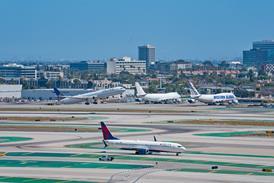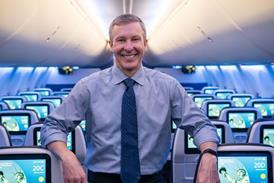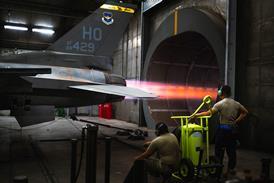Asian airlines are for the most part declaring the economic downturn over. Does SALE agree with this assessment? In terms of the so-called downturn in Asia-Pacific, the general trend is that the market has come out of the downturn. Some parts of the market have come out of the downturn quicker than others in Asia. In particular we saw some pretty heavy traffic growth up in northern Asia - Korea in particular - helped by the fact that a number of airlines had pulled off those routes. This year we're going to see some negative factors which are going to slow down the speed of the recovery and profitability. There are two negative factors which are already implicit. One is the increase in fuel prices, which is going to hit airlines' profit and loss accounts this year. The second thing is US dollar interest rates, which are creeping upwards. So, for those airlines which haven't hedged their debt, that's going to have some impact. And of course while load factors have increased as the planes are filled up, the other thing is that yields have not increased as quickly. Yields are still low and that is an important factor, particularly for those European airlines which may have wanted to move capacity off routes in North Atlantic for example and move them back onto Asian routes as we're getting more competition in the North Atlantic. So this means some of the European carriers may find it difficult to compete in the Asian market. Has SALE seen an increase in interest lately in the wake of the recovery? Are you fielding more calls from Asian carriers? Without a doubt. Here in Asia the number of calls we've had from Asian airlines wanting aircraft in a hurry has substantially increased. The problem is they all want them tomorrow. The first sort of calls that are coming in are basically airlines wanting to bridge capacity until their own orders, which they have previously deferred, come in. In terms of longer-term deals, those calls are coming in, but the airlines are sitting back and looking at their fleet strategy and saying, 'Do we buy or do we lease?' The good news is that at least this time they are considering leasing, whereas previously they would have just bought. Are Asia's airlines more inclined to turn to operating leases now and if so, why? Yes. I think there are two reasons why they are more inclined to go for operating leasing. The first thing is there is a much greater focus on the bottom line, on profitability. People are looking more carefully at their balance sheets, and flexibility in terms of upgrading or downgrading their aircraft sizes, as the balance of their route structures changes and as the volume of traffic on routes changes. The other important point is that Asian airlines are focusing now on residual values, and they realise that to have an effective plan as to when they lock in their residual exposures is very important. So you're seeing a number of carriers making active use of the sale and lease-back market to plan ahead, ready to finance future deliveries to come. SALE has done quite a few sale and lease-backs in recent years. Is that an area you will continue to focus on? Our core business is purchasing reasonably large numbers of aircraft directly from the manufacturers and supplementing that with a lesser number of sale and lease-backs. It's fair to say that the best time for us to do sale and lease-backs is when the market is down, when the banks aren't lending as much money and when the competition is less. Providing we're happy with the long-term credit risk of the carriers that we do the deals with, then we should be doing those deals. That was the view we took during the recession here in Asia, and we will take the same view if Europe or the US takes a downturn. We always allocate a certain amount of our balance-sheet capacity to the sale and lease-back market. We will not do the deals if they don't make economic sense. We don't have to do it, but if it makes sense we will do it. Has SALE done well out of the Asian economic downturn? It is fair to say that we have utilised our global capabilities to the full. We were placing the new aircraft in the European, Middle Eastern and North American markets when Asia was in recession. At the same time we were actively seeking sale and lease-back business here in Asia as and when that became available. What have Asia's airlines learned from the downturn? It really comes down to two areas: the importance of fleet flexibility and the importance of planning when they lock in their residual exposures. Will the growth that SALE has had over the past few years continue? When you consider that we started back in 1993 with our first aircraft, and today we have 26 aircraft in the portfolio, certainly we've grown rapidly. I would expect that we will be up above 50 aircraft in five years' time. We now have an order book that is visible for all to see, and so the rate of growth will be slower, but in terms of the numbers of aircraft it will be similar. If you look at our balance sheet today in terms of assets, we're roughly 50-50 between narrow-bodies and wide-bodies. And that's the way that we intend to grow - roughly that split between the narrow-body and wide-body market. As you know our focus to date is on the A320s on the narrow-body side and 777s on the wide-body side. Any possibility to expand to other aircraft types? We will consider further diversifying the portfolio as and when we think the markets are there for each aircraft type. What are the biggest potential markets for SALE? We like to describe ourselves as a global player from an Asian base. And that's what distinguishes us from our competitors - the Asian base. In terms of aircraft markets, certainly the A320-family market, B777-family market; in terms of geographic markets, we will build a diversified portfolio globally. There's no specific market we will focus on, but it's fair to say that we will follow the same strategy as previously - when markets are down we'll be doing more sale and lease-backs in that particular market; when markets are up we'll be placing more aircraft in that particular market. Airbus and Boeing are watching the development of airline alliances very closely in terms of the potential impact they may have on their business. Will there be an impact on the operating leasing business? We have not seen any major change in the way that airlines source aircraft on operating lease, due to alliances. That may be down to the fact that a lot of the major airlines in the alliances think of operating leasing still as a part of their portfolio but not the major source. The way that a number of them do operating leasing is less planned in advance. The one exception to that is the SAirGroup, where we have seen a change in behaviour since they set up an in-house leasing company.
Asian airlines are for the most part declaring the economic downturn over. Does SALE agree with this assessment?
In terms of the so-called downturn in Asia-Pacific, the general trend is that the market has come out of the downturn. Some parts of the market have come out of the downturn quicker than others in Asia. In particular we saw some pretty heavy traffic growth up in northern Asia - Korea in particular - helped by the fact that a number of airlines had pulled off those routes.
This year we're going to see some negative factors which are going to slow down the speed of the recovery and profitability. There are two negative factors which are already implicit. One is the increase in fuel prices, which is going to hit airlines' profit and loss accounts this year. The second thing is US dollar interest rates, which are creeping upwards. So, for those airlines which haven't hedged their debt, that's going to have some impact.
And of course while load factors have increased as the planes are filled up, the other thing is that yields have not increased as quickly. Yields are still low and that is an important factor, particularly for those European airlines which may have wanted to move capacity off routes in North Atlantic for example and move them back onto Asian routes as we're getting more competition in the North Atlantic. So this means some of the European carriers may find it difficult to compete in the Asian market.
Has SALE seen an increase in interest lately in the wake of the recovery? Are you fielding more calls from Asian carriers?
Without a doubt. Here in Asia the number of calls we've had from Asian airlines wanting aircraft in a hurry has substantially increased. The problem is they all want them tomorrow.
The first sort of calls that are coming in are basically airlines wanting to bridge capacity until their own orders, which they have previously deferred, come in. In terms of longer-term deals, those calls are coming in, but the airlines are sitting back and looking at their fleet strategy and saying, 'Do we buy or do we lease?' The good news is that at least this time they are considering leasing, whereas previously they would have just bought.
Are Asia's airlines more inclined to turn to operating leases now and if so, why?
Yes. I think there are two reasons why they are more inclined to go for operating leasing. The first thing is there is a much greater focus on the bottom line, on profitability. People are looking more carefully at their balance sheets, and flexibility in terms of upgrading or downgrading their aircraft sizes, as the balance of their route structures changes and as the volume of traffic on routes changes.
The other important point is that Asian airlines are focusing now on residual values, and they realise that to have an effective plan as to when they lock in their residual exposures is very important. So you're seeing a number of carriers making active use of the sale and lease-back market to plan ahead, ready to finance future deliveries to come.
SALE has done quite a few sale and lease-backs in recent years. Is that an area you will continue to focus on?
Our core business is purchasing reasonably large numbers of aircraft directly from the manufacturers and supplementing that with a lesser number of sale and lease-backs. It's fair to say that the best time for us to do sale and lease-backs is when the market is down, when the banks aren't lending as much money and when the competition is less. Providing we're happy with the long-term credit risk of the carriers that we do the deals with, then we should be doing those deals. That was the view we took during the recession here in Asia, and we will take the same view if Europe or the US takes a downturn.
We always allocate a certain amount of our balance-sheet capacity to the sale and lease-back market. We will not do the deals if they don't make economic sense. We don't have to do it, but if it makes sense we will do it.
Has SALE done well out of the Asian economic downturn?
It is fair to say that we have utilised our global capabilities to the full. We were placing the new aircraft in the European, Middle Eastern and North American markets when Asia was in recession. At the same time we were actively seeking sale and lease-back business here in Asia as and when that became available.
What have Asia's airlines learned from the downturn?
It really comes down to two areas: the importance of fleet flexibility and the importance of planning when they lock in their residual exposures.
Will the growth that SALE has had over the past few years continue?
When you consider that we started back in 1993 with our first aircraft, and today we have 26 aircraft in the portfolio, certainly we've grown rapidly. I would expect that we will be up above 50 aircraft in five years' time. We now have an order book that is visible for all to see, and so the rate of growth will be slower, but in terms of the numbers of aircraft it will be similar.
If you look at our balance sheet today in terms of assets, we're roughly 50-50 between narrow-bodies and wide-bodies. And that's the way that we intend to grow - roughly that split between the narrow-body and wide-body market. As you know our focus to date is on the A320s on the narrow-body side and 777s on the wide-body side.
Any possibility to expand to other aircraft types?
We will consider further diversifying the portfolio as and when we think the markets are there for each aircraft type.
What are the biggest potential markets for SALE?
We like to describe ourselves as a global player from an Asian base. And that's what distinguishes us from our competitors - the Asian base. In terms of aircraft markets, certainly the A320-family market, B777-family market; in terms of geographic markets, we will build a diversified portfolio globally. There's no specific market we will focus on, but it's fair to say that we will follow the same strategy as previously - when markets are down we'll be doing more sale and lease-backs in that particular market; when markets are up we'll be placing more aircraft in that particular market.
Airbus and Boeing are watching the development of airline alliances very closely in terms of the potential impact they may have on their business. Will there be an impact on the operating leasing business?
We have not seen any major change in the way that airlines source aircraft on operating lease, due to alliances. That may be down to the fact that a lot of the major airlines in the alliances think of operating leasing still as a part of their portfolio but not the major source. The way that a number of them do operating leasing is less planned in advance.
The one exception to that is the SAirGroup, where we have seen a change in behaviour since they set up an in-house leasing company.
Source: Flight Daily News























